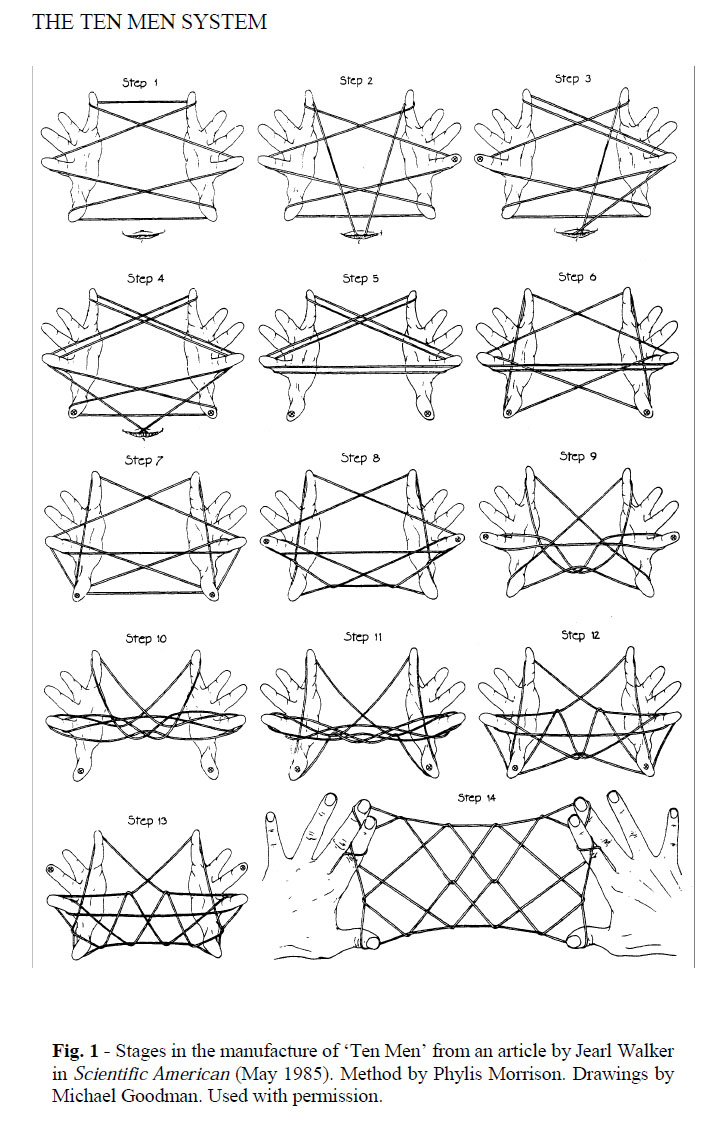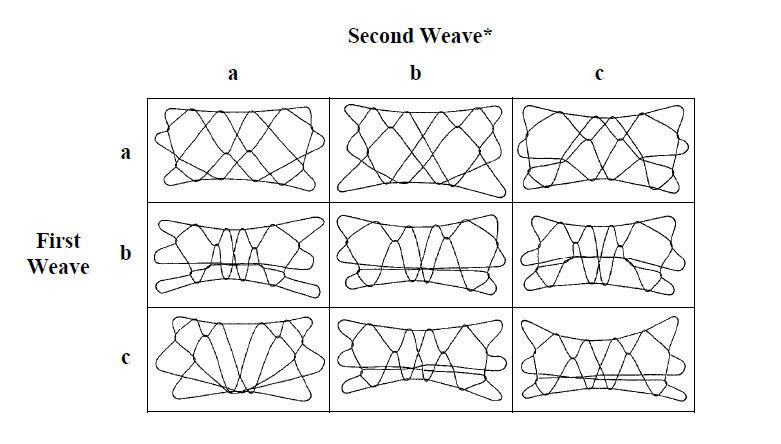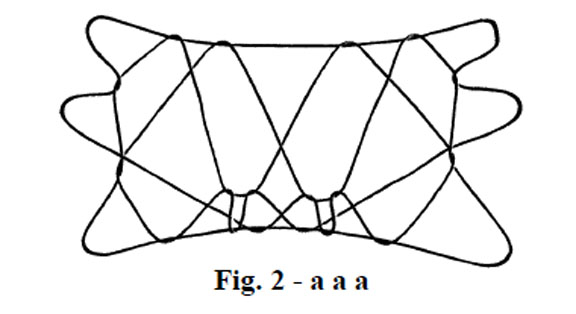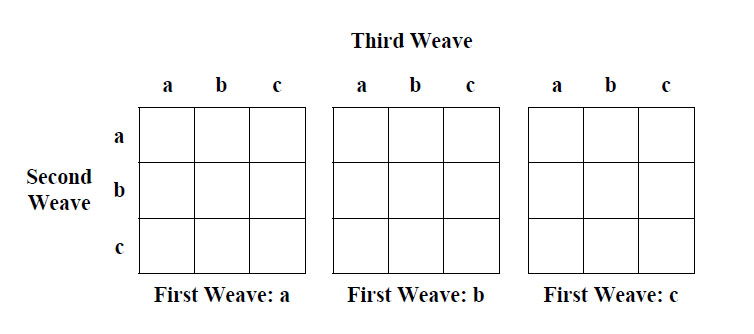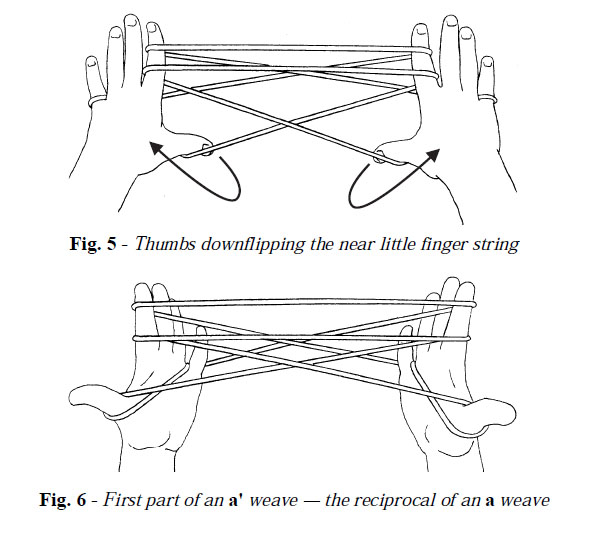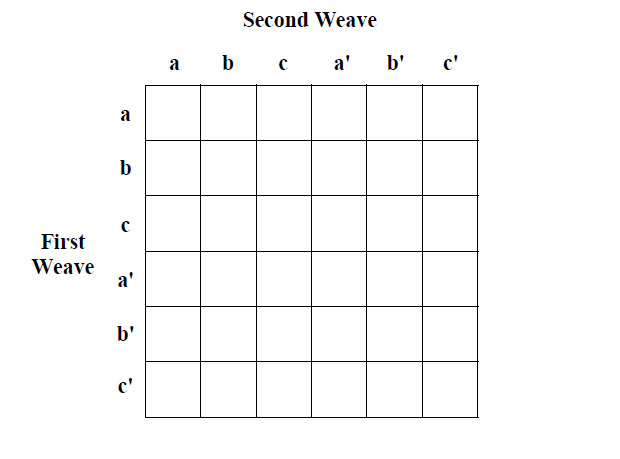TEN MEN – A SIMPLE THREE-LOOP SYSTEM
LESSON 1: LEARNING THE TEN MEN FIGURE
During the first lesson students are taught how to make the Ten Men figure (Ten Men was first described in 1906 by Caroline Furness Jayne. Something can be immediately discerned concerning the digital resourcefulness of each student (i.e., which ones have intelligent hands, and which ones have trained hands). There are subtle differences, just as there are nuances we as teachers perceive in the verbal development of our students along several vectors (memory, diction, depth of perception, logicality of approach, style of expression, writing ability, aptness of metaphor or analogy, facility and felicity). All these are evident in the students’ hands as they struggle to make accurate and quick the formation of their figures. Before attempting to weave any of the figures described in this article, i suggest that you read the lessons through to get the gist of the development tree. See if you can follow the perverse logic of the unfolding mysteries of forming different, more complex figures. And always keep in mind that i have found no student, repeat no student, in my fifteen years of constantly teaching string figures, who did not only succeed in making the figures, but revelled in their sophistication of result. Inevitably the student is made stronger by their overcoming rustration on this level. To help my students assimilate the Ten Men figure, i divide its construction sequence into five distinct phases: Forming the Loom, Weaving, Resetting the Loom, Weaving Again, and Extending the Figure:
Forming the Ten Men Loom
- Begin with Opening A (fig. 1, Step 1).
- With your mouth reach over all the strings and return with the far little finger string (Step 2).
- With your right index reach over the right mouth string, pick up the left mouth string and return (Step 3).
- With your left index pick up the right mouth string and return (Step 4).
- Release the mouth loop and the loop on each thumb and extend (Step 5).
You now have the Ten Men Loom. The upper and lower near index strings should run directly from hand to hand without crossing. These two strings will become the frame lines of the finished pattern.
Weaving (first iteration)
- With each thumb reach under both index loops, pick up the near little finger string, and return (Step 6). This step constitutes the FIRST PART OF THE WEAVE.
- With each thumb pick up the upper near index string, keeping it above the loop already on the thumb (Step 7).
- Navaho the thumb loops (Step 8).
Resetting the Loom
- On each hand release the upper index loop and extend (Step 9).
- On each hand transfer the thumb loop to the index finger (without inverting or twisting the loop), keeping the transferred loop above the loop already on each index (Step 10).
Weaving (second iteration)
- With each thumb reach under both index loops, pick up the near little finger string, and return (Step 11).
- With each thumb pick up the upper near index string, keeping it above the loop already on the thumb (Step 12).
- Navaho the thumb loops (Step 13).
- (Note that you do not finish the weave and reset the loom now. Instead proceed immediately to the extension)
Extending the Figure
- With each middle finger reach over the upper far index string and pick up the (lower) near index string.
- Release the little finger loops and extend with palms facing away from you (Step 14).
When extended you should have a web or net formed between your hands with ten X’s in it. Each of these X’s represents a man doing a side-straddle hop exercise and that is the derivation of the name Ten Men. Instruct your students to practice this figure until they have memorized how to form it. It is the heart of the system i am proposing. As the students practice making the figure, i emphasize the division of the sequence into phases (setting up the loom, weaving, resetting the loom, weaving again, and extending). The reason for this division is to introduce the concept of systematically altering each phase — a technique which leads to an almost infinite series of different designs.
ALTERING THE WEAVING PHASE
LESSON 2: CREATING SIMPLE VARIATIONS OF TEN MEN
Once my students have mastered the parent figure, i teach them how to alter the weaving phase using a variety of techniques. These techniques include altering the string retrieved by the thumbs, altering how this string is retrieved, and altering the path taken by the thumbs prior to retrieving the desired string. Also, i introduce the concept of repeating the weaving phase more than twice. Suppose you forgot which little finger string to pick up with your thumbs when beginning your first weave and picked up the far little finger string instead of the near little finger string. Remarkably, a different figure results (i.e., the design does not collapse). Retrieving the far little finger string during the second weave (or during the first and second weaves) also gives rise to new designs. Perhaps we should pause and consider how to organize our search for different patterns as our creative play progresses:
Consider the following three simple weaves (here i use a single lowercase bold letter as shorthand notation for indicating which string is retrieved by the thumb during each weaving phase and how it is retrieved):
a (pick up the near little finger string as in Ten Men)
b (pick up the far little finger string under the near little finger string)
c (pick up the far little finger string over the near little finger string)
Now consider how many different two-weave patterns you can make. Using my shorthand notation, the original Ten Men figure would be written as a a. Another figure would be a b, with a third being a c. Now consider weaving b first or c first. You can see it gets complicated to store the results in your head. In class i encourage my students to use a simple matrix to explore these possibilities. The result of each combination can be sketched within the squares of a matrix:
You might wish to think about repeating the weaving phase more than twice. There is no reason to limit yourself to two weaving phases except for habit and lack of imagination. So try a a a. A fine pattern results (fig. 2). Next, try a a b (fig. 3), or a b a (fig. 4), or other three-weave combinations. To explore all these combinations you would need three matrices:
Now comes a new imaginative difference which leads to a real mystery. Suppose you didn’t pick up the near little finger string with the thumb in the regular way but instead “downflipped” it by placing your thumb on top of the near little finger string and curling your thumb down and toward you as you returned (fig. 5). The resulting thumb loops now have a half twist in them (fig. 6). This weave i call a’ (a-prime). That is because it is the reciprocal or inverse of the a weave.
To illustrate what i mean by reciprocal, try the following experiment: First do an a weave (i.e., pick up the near little finger string on the back of the thumb, pick up the upper near index string, and navaho the thumb loops), then reset the loom (i.e., release the upper index loops and transfer the thumb loops to the indices). Now do an a’ weave (same as a, but downflip the near little finger string), and again reset the loom. You should have reverted back to the original loom (fig. 1, Step 5). The two weaves cancel themselves out when both are woven and reset in either order. Now think of the possible three-weave patterns for figures starting with the a weave. You would need a 6-by-6 matrix to record the outcome of each combination:
Take special note of the row beginning with a’. For each figure in this row an incomplete design results (nothing encircles the upper frame string) since the first and second weaves cancel each other (i.e., weaving a a’ a is the same as weaving only a — see fig. 7).
You should also note that you will have to find a method of “downflipping” the c weave artificially. The thumb can’t curl down, toward you, and back up without also picking up the near little finger string along with the far little finger string. Therefore, you will need to practice pulling a c weave and then adjusting the loop on each thumb to create what would have been a downflip of the c weave if it had been physically possible. Perhaps the easiest way is to simply lift the new loop off each thumb, rotate the loop half a turn away from you, reset the loop on the thumb, then finish the weave (i.e., pick up the upper near index string and navaho thumbs). There is also a method of flipping the string which is not as natural, but which must be thought of in order to round out the possible differences in our weaving patterns. In the inverse weaves described above, we artificially formed the “downflip” of the c weave by rotating the new thumb loop half a turn away and then resetting it. The anti-inverse would be formed by rotating the new loop half a turn towards you (fig. 8). Finishing the weave would then result in a running half-hitch in the figure. And obviously all the weaves described so far will have an inverse and an anti-inverse (a prime and a double prime in my notational system). However, i haven’t found any real use for anti-inverse weaves except for introducing a half-hitch into the design.

